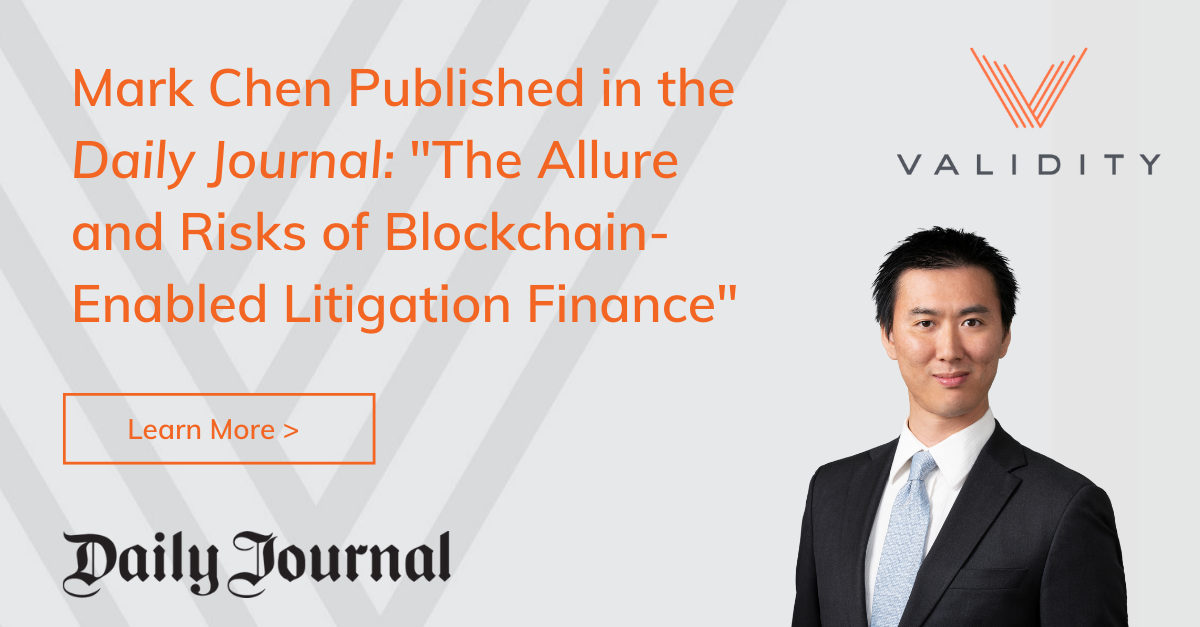March 22, 2023

Mark Chen's article, "The Allure and Risks of Blockchain-Enabled Litigation Finance" was published in the Daily Journal on March 22, 2023. The article is reproduced below, and can also be viewed on the Daily Journal's website here (subscription may be required).
The Allure and Risks of Blockchain-Enabled Litigation Finance
Imagine being able to log into an app on your smartphone to buy and sell different litigation tokens on an unregulated, decentralized exchange the way that investors can day-trade in stocks. Investors could also pursue more complex strategies, with defendants buying litigation tokens to hedge risk, and investors short-selling tokens as part of an investment strategy. A “cryptofied” approach to funding is alluring but poses significant risks to investors and litigants.
The advent of blockchain technology has enabled developers to reimagine an array of traditional financial products – from currency exchanges to fractional banking and collateralized lending. And now, not surprisingly, we are seeing some early experimentation with “crypto-powered” litigation finance, offering a crowdfunding model for retail investors to take up a stake in the outcome of commercial litigation. This article will explore how blockchain-enabled litigation finance works and examine some of the significant risks and challenges it poses to investors and litigants.
But before we dive into the “cryptofication” of litigation finance, let’s first address what litigation funding traditionally looks like: it is a process whereby a third-party provides nonrecourse funding to a litigant and, in return, receives a negotiated portion of the litigant’s proceeds if the claim is successful. Over the last decade, litigation funding has steadily gained popularity amongst litigants as a tool for managing risk and retaining quality counsel. Over the past year, 44 active funders managed a combined $13.5 billion in assets allocated to US commercial litigation investments. These funders take on significant risk: if the litigant loses their suit, then the funder loses the entirety of its investment.
The Emergence of Crypto-backed “Initial Litigation Offerings” (ILO)
The “crypto-based” version of litigation finance replaces the traditional funder with a promoter, who raises funds for the litigant by creating crypto tokens to represent fractional shares in the litigation funding investment and then selling those “litigation tokens” to investors. Anyone who wishes to invest in the litigant’s claim can do so by purchasing the tokens. If the litigant wins the suit, the token-holders receive a return on their investment based on the number of litigation tokens they hold. The returns are paid out in cryptocurrency (typically a dollar-backed stablecoin). If the litigant’s claim fails, then the token becomes worthless. The promoter receives a share of the funds raised and the tokens sold as compensation for its efforts. Apothio’s self-titled “initial litigation offering,” which closed in March 2022, was the first example of this approach.
While proponents tout this new technology as a digital revolution that will “democratize” the practice of litigation funding and increase capital efficiency, the method by which crypto-powered financing attempts to accomplish these goals raises a host of policy concerns and creates significant risks for investors and litigants.
To be sure, this crypto-based approach makes litigation funding more accessible as an investment. Whereas traditional funding is typically limited to private institutions and accredited investors, crypto-funders have sought to structure their “initial litigation offers” such that anyone can participate. Indeed, Apothio’s offering required only a $100 minimum investment.
More importantly, tokenizing litigation investments allows litigation funding to access the whole suite of “decentralized finance” products on the blockchain, which carries profound consequences. Imagine being able to log into an app on your smartphone to buy and sell different litigation tokens on an unregulated, decentralized exchange the way that investors can day-trade in stocks. Investors could also pursue more complex strategies, with defendants buying litigation tokens to hedge risk, and investors short-selling tokens as part of an investment strategy. Litigation token-holders could even pledge their tokens as collateral to take out a loan via decentralized lending, or effectively insure their tokens via options contracts. The decentralized nature of these products make them extremely difficult to regulate or censor – most are not governed by any particular entity, but instead run autonomously via smart contracts (self-executing contracts written in the form of computer code and stored on the blockchain). Furthermore, the nature of the blockchain can make it difficult to determine the identities of participants.
One can easily imagine how creating a “stock market” for litigation finance under these circumstances might produce perverse incentives, such as litigants seeking to maximize the “share price” of their claims rather than simply litigating the claims on their merits. But setting aside for now the potential ramifications to the integrity of the judicial system, the crypto-powered approach to funding also presents significant risks to investors and litigants.
A Risky Proposition for Investors
While crypto-powered finance makes funding more accessible to retail investors, the ability for a retail investor to evaluate the merits of a case is handicapped by extreme information asymmetry. The litigant, who knows the most about their case, as well as the promoter both have an incentive to paper over any flaws to raise more funds. The investor’s ability to verify the litigant’s representations, however, is limited by the investor’s inability to review non-public materials. For example, investors may not even be able to see the contracts underlying a commercial dispute, if those contracts have been deemed confidential.
By contrast, litigants dealing with a traditional funder can and do share confidential materials under an NDA. Traditional funders also typically retain seasoned trial counsel to carefully evaluate the claims, to ensure that their investors’ funds are committed only to meritorious cases with a strong likelihood of success.
Key Considerations for Litigants
For litigants seeking funding, the crypto-funding approach presents three primary issues:
Crypto-funding lacks the flexibility necessary to address the unpredictable nature of litigation. A sophisticated funder can utilize creative funding structures to match the needs of the litigant and the case. For example, a funder might offer to deploy capital on an as-needed basis rather than all upfront with an ILO, with the funder’s returns based on the amount of capital actually deployed. If the litigant resolves the case early, then the litigant only gives up a small portion of the return. This structure also limits the funder’s risk, which allows the funder to offer better pricing.
In the crypto context, funding disputes will be difficult to resolve because the litigant would have to negotiate with thousands of crypto investors, some of whom might be completely anonymous. Further, any number of investors may decide to file suit. Disputes with a traditional funder, on the other hand, can more easily be resolved through traditional negotiations. Indeed, funders have an incentive to act as good partners to maintain their reputation.
The crypto-funding approach also presents misalignment risks. A good litigation funder will carefully calibrate the investment structure so that (a) counsel is motivated to litigate the case effectively; (b) the litigant can reasonably settle the case and keep most of the recovery; and (c) the funder is incentivized to fully support the litigant’s goals throughout the life of the case. With crypto-funding, there is no one to ensure that this alignment is present. In fact, crypto investors could easily develop interests that are averse to the litigant. For example, a large investor seeking to exit early (by selling tokens on a decentralized exchange) might engage in a public relations campaign to hype up the value of the ILO token, without considering whether the campaign ultimately hurts the litigant’s case.
At the end of the day, the application of blockchain technology to litigation funding extends new opportunities to retail investors and opens a new funding avenue to litigants. But it also restricts investors’ ability to evaluate the strength of a case while simultaneously allowing investors to profit from litigation in ways that are unrelated to the merits of the claim. It remains to be seen whether this nascent, crypto-based litigation funding strategy truly gains traction, but investors and litigants would be wise to consider the above challenges before testing those waters.
